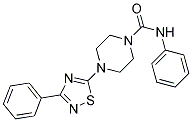| Cas No.: | 681136-29-8 |
| Chemical Name: | 1-Piperazinecarboxamide, N-phenyl-4-(3-phenyl-1,2,4-thiadiazol-5-yl)- |
| Synonyms: | Takeda-25,JNJ-1661010,JNJ 1661010 |
| SMILES: | O=C(NC1=CC=CC=C1)N(CC2)CCN2C3=NC(C4=CC=CC=C4)=NS3 |
| Formula: | C19H19N5Os |
| M.Wt: | 365.45 |
| Purity: | >98% |
| Sotrage: | 2 years -20°C Powder, 2 weeks 4°C in DMSO, 6 months -80°C in DMSO |
| Description: | FAAH preincubated with JNJ-1661010 suggests a slow reversibility of the interaction between the JNJ-1661010 and the active site, which is accelerated at higher temperatures. JNJ-1661010 is a covalent, mechanism-based substrate inhibitor as examined by LC-ESI-MS. JNJ-1661010 docks with the phenylthiadiazole in the hydrophobic tunnel and the phenylurea in the hydrophilic pocket of FAAH. JNJ-1661010 (20 mg/kg i.p.) inhibits FAAH by at least 85% For up to 4 h after dosing, resulting accumulation of lipid ethanolamides in rat brain. JNJ-1661010 dose-dependently reverses the tactile allodynia with a maximum efficacy of approximately 90% at 30 min postdose in both Mild Thermal Injury (MTI) mice and rat model. JNJ-1661010 (20 mg/kg) reverses tactile allodynia by 60.8% at 30 min in rat spinal nerve ligation injury model. JNJ-1661010 (50 mg/kg i.p.) shows a significant attenuation of the hyperalgesia at 30 min postdose in rat carrageenan model of inflammatory pain. Rats dosed with JNJ-1661010 (20 mg/kg i.p.) has a plasma Cmax of 26.9 μM at the Tmax of 0.75 h and a Cmax in the brain of 6.04 μM at the Tmax of 2 h. JNJ-1661010 (20 mg/kg i.p.) inhibits brain FAAH and elevates AEA level in brain tissue in rat. For the detailed information of JNJ-1661010, the solubility of JNJ-1661010 in water, the solubility of JNJ-1661010 in DMSO, the solubility of JNJ-1661010 in PBS buffer, the animal experiment (test) of JNJ-1661010, the cell expriment (test) of JNJ-1661010, the in vivo, in vitro and clinical trial test of JNJ-1661010, the EC50, IC50,and Affinity of JNJ-1661010, Please contact DC Chemicals. |

 To enhance service speed and avoid tariff delays, we've opened a US warehouse. All US orders ship directly from our US facility.
To enhance service speed and avoid tariff delays, we've opened a US warehouse. All US orders ship directly from our US facility.




















